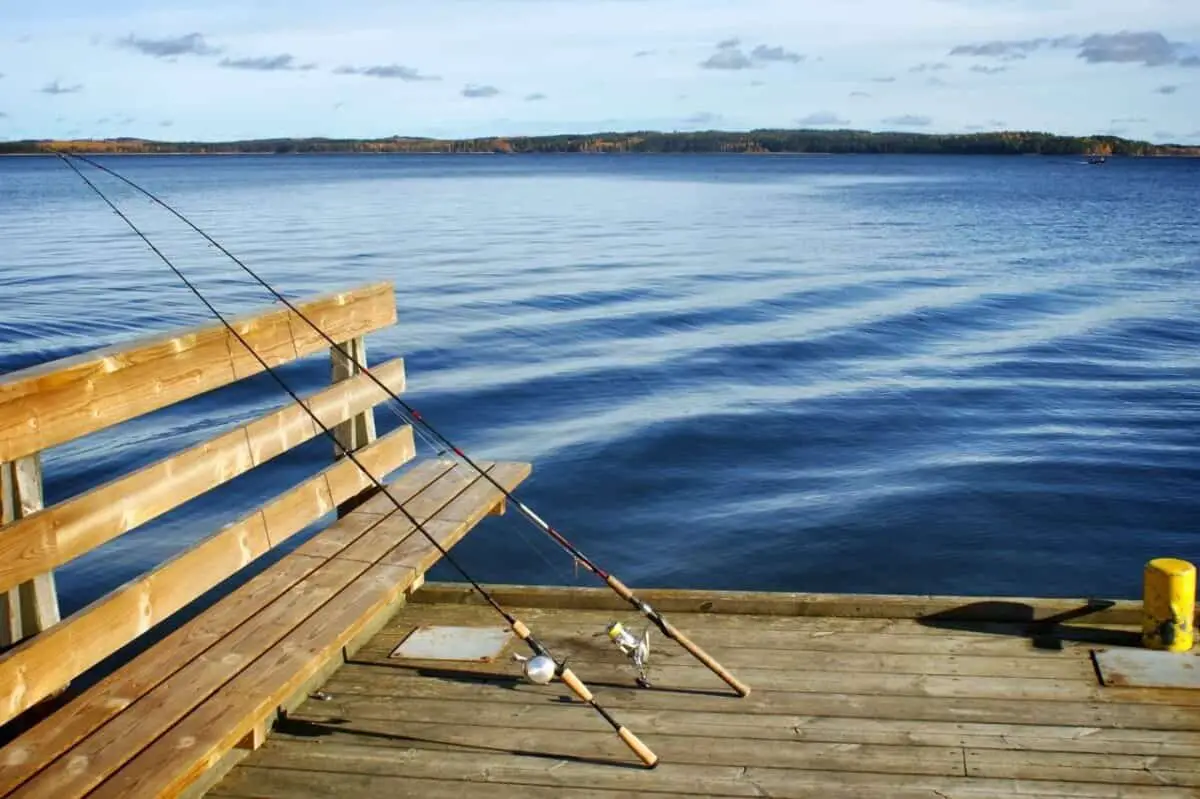Experienced anglers around the world know that sometimes, a good day of fishing comes down to pure luck. Of course, some days, the fish won’t bite, but that doesn’t stop an endless debate on how to up your odds. The time of the day, season, water, quality of one’s rods, reels, and type of bait you’re using are all factors to consider whether or not you’ll have a productive day on the water. But have you ever wondered if you could increase your luck by fishing with two rods? In this article, we’ll answer the question and provide some clarity on this topic.
Many anglers recommend fishing with two or more rods. Depending on your location, however, rules and regulations vary, and an extra fee may be required to fish with more than one rod. Therefore, it’s a good idea to check the rules before your trip and make sure that your fishing license permits fishing with two rods if you plan to do so.
We’ll dive into the world of fishing with a focus on simultaneous two-rod fishing. We’ll briefly discuss rod types and configurations, as well as answer a few of your most common questions about fishing rods, so stay with us right to the end.
A lot of fishing rods and reels can last a lifetime, handle a wider variety of fish, and can take a beating. Whether you are looking for your very first fishing rod or want to buy a new one, we’re sure that our list holds a lot of options. Read our article to discover our best fishing rods recommendations.
Why Fish With Two Rods?
Many experienced anglers recommend fishing with two rods to get the most out of your day. And indeed, you can partake in several kinds of fishing with two rods, including ice fishing, boat fishing, shore fishing, trolling, or dock fishing, to name a few.
Now that you know fishing with two rods is permitted in most areas, let’s find out why anglers like to do so. Below are some of the most popular reasons why anglers enjoy fishing with two (or more) rods at a time.
It Saves Time
Many anglers like to fish fast and efficiently. One such example is bass fishers, who could spend a good amount of their time switching out their rigs and tying on bait. Instead, if they have two or more rods, they can switch without a lot of fuss, thus saving time in the process.
Try Different Configurations
Anglers, like anyone else, like to try new things. Fishing with two or more rods gives them the flexibility to try different configurations with their lines, hooks, baits, and reels. That way, they may discover that what they’ve been accustomed to using isn’t always the best option.
Try Again With the Same Fish
If you miss a fish with one rod, often, if you have a follow-up lure to cast, they could very well bite the second time around. For this reason, many anglers enjoy having two rods when fishing.
Lure Different Kinds of Fish
If an angler is fishing for different kinds of fish, two rods could be beneficial. For example, if you’re out on the water fishing for both small-mouth and big-mouthed bass, your methods could be very different and require two lines.
For beginner anglers, fishing may seem complicated. But don’t be discouraged because once you finally learned the basics, you’ll be able to reap the benefits of this activity. If you’re a beginner, check out our article to learn how to use a fishing rod.
Types of Fishing Rods
Now that you understand the benefits of fishing with two rods, you may be wondering what types of fishing rods are best for you. Unfortunately, with so many choices on the market, it can get overwhelming.
First off, you’ll want to consider the right length of rod for you. Rods range anywhere from 4 to 14 feet (source
Longer rods allow for a more extended cast but can be harder to handle for a novice angler. Meanwhile, shorter rods are easier to control but might limit how far you can cast. For beginners, a 7′ fishing rod is a good starting point.
Rod Materials
Rods on the market today are typically constructed with the following materials:
- Fiberglass
- Composite
- Graphite
Fiberglass rods have been around for a very long time. They are reliable, durable, and also quite affordable, making them an ever-popular choice. However, the drawbacks to fiberglass are that they are so pliable that they aren’t as sensitive. Thus, lighter bites could be harder to detect. They are also heavier than other materials and can tire you out if you’re wrestling a fish for an extended time.
Graphite rods have been around since the ’70s and are a lighter alternative to fiberglass. However, they are stiffer rods and are more sensitive to bites than their fiberglass counterpart. The drawbacks here are that they can break more easily due to stiffness and tend to be more expensive than fiberglass rods.
Composite rods are a mixture of graphite and fiberglass. Their main benefit is their versatility, which allows you to fish in various waters. If you’re looking for performance, this is the rod for you.
Rod Action
Besides length and material, a rod’s action is another component to consider with your fishing rod. This factor determines how far and where the rod bends. Therefore, action is another factor that determines how you manage your rod and what type of fish you’ll be able to catch.
Fast-action rods will bend at the uppermost part of your pole, making them very sensitive to bites. They are an excellent option for larger fish.
Medium-action rods bend at the top half of the pole and are a great choice for large and small fish. They work with multiple hook setups and far casting.
Slow-action rods are bendable throughout the rod. For slow-action rods, you will want to use your smallest lure to get a good cast. They aren’t as easy to set a hook in but are ideal if you’re not a strong caster or if you’re river and stream fishing (source
Your fishing rod and reel are the most vital components to catch fish, therefore, you must clean them after each use. Knowing how to properly care for and maintain your fishing rod and reel is important to make your investment last many years. Read our article to learn how to take care of your fishing rod and reel.
Frequently Asked Questions (FAQs)
What Are the Different Types of Fishing Reels?
Now, you may also want to learn about fishing reels. There are three main types of fishing reels:
- Spincast fishing reels
- Spinning reels
- Baitcast reels
Spincast fishing reels are an excellent choice for beginners because they are easy to use and inexpensive. In addition, the push-button reel makes them easier to cast than the other two options. However, the downside of spincast fishing reels is they tend to not be as durable and may lack accuracy when casting.
Spinning reels are more efficient and durable than spincast reels and offer more versatility when it comes to the types of fish you’re going after. However, these reels can also tangle more easily and are more expensive than spincast reels.
Baitcast reels are the top-of-the-line reel for more advanced anglers. They are the most durable and accurate but are also quite pricey. Besides, beginners may find it challenging to learn how to cast with those. However, once you’ve mastered this kind of reel, you can pull in some mighty catches.
Many experienced anglers or competitive fishermen recommend using both a spinning reel and a baitcaster while out on the water as spinning reels are beneficial if you’re fishing with a light line (8-pound test or less), while a baitcaster is excellent for fishing with a heavier line (10 pounds or more) (source
Types of Fishing Lines
The fishing line is another essential component to consider when it comes to your setup. Depending on the type of fishing you’ll be doing, the line will make a difference. The three main types of line are:
- Monofilament
- Fluorocarbon
- Braided
Monofilament fishing lines have been popular for over 60 years and are the most familiar kind of line to experienced anglers. These lines are nylon-based. Their main benefits are how soft and stretchy they are, favoring easy knotting and less slippage. Many anglers prefer monofilament lines because they cut cleanly with clippers and casts light lures with spinning gear with ease, according to Outdoorlife.com (source
A mono fishing line is not recommended for deepwater fishing as the lines can absorb water, but are fine for boat fishing and typically any novice angler.
A fluorocarbon line is the most expensive type of fishing line. It offers less stretch and won’t absorb water like a mono, making it better for deepwater fishing or trolling. It’s more rigid and more abrasion-resistant than mono as well. A fluorocarbon line is also virtually invisible in the water. Therefore, anglers can use this line in heavier pound tests over other more visible lines. However, one considerable drawback is that these lines are more difficult to knot than mono lines due to their stiffness.
Braided lines have recently gained popularity due to their high abrasion resistance and easy casting capabilities. They are smaller in diameter than mono fishing lines but have a higher pound test. Some anglers prefer braided lines because they don’t have any stretch. The lack of stretch makes the lines extremely sensitive, so that an angler will feel the slightest bite on their line. A braided fishing line has a lot of knot strength. However, some drawbacks to this type of line are that it’s more expensive than mono and can be more difficult to knot. Braided lines are not recommended for inexperienced anglers. Besides, they can be dangerous since they can easily cut the skin.
Sometimes, carrying fishing equipment can be inconvenient. One way to address this situation is by bringing a telescopic fishing rod instead. This kind of rod is very easy to transport because theyit can collapse down to a shorter length. But, are telescopic fishing rods any good? Read our article to find out.
Conclusion
If you have fished before or know someone who is an avid fisher, you’ll know that fishing is mostly a waiting game. Sometimes, the fish don’t even bite at all. If you want to increase your chances of catching a fish, seasoned anglers recommend that you try fishing with two rods simultaneously.
Fishing with two rods allows you to fish more efficiently. Not only do you increase your chances of getting a bite, you also save time by being able to try different fishing configurations at the same time. Fishing with two rods is also a good time to try out different kinds of rods and baits. If you haven’t tried this kind of fishing before, then it’s to plan your next fishing trip and improve your fishing game.

